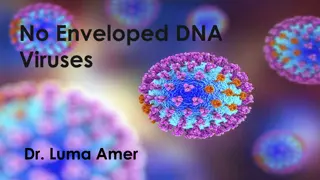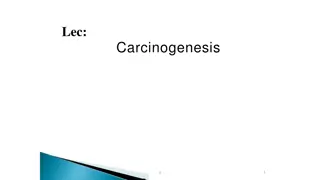Carcinogenesis
The multistep process of carcinogenesis at both phenotypic and genetic levels, including excessive growth, local invasion, and metastasis. Explore the six changes in normal cell physiology that result in cancer formation and the mechanisms of action of oncoproteins. Discover the role of important genes in controlling the signaling pathway and the model for action of RAS genes.
- carcinogenesis
- multistep process
- phenotypic level
- genetic level
- autonomous growth
- oncoproteins
- signaling pathway
Download Presentation

Please find below an Image/Link to download the presentation.
The content on the website is provided AS IS for your information and personal use only. It may not be sold, licensed, or shared on other websites without obtaining consent from the author. Download presentation by click this link. If you encounter any issues during the download, it is possible that the publisher has removed the file from their server.
E N D
Presentation Transcript
Carcinogenesis DR. AYSER HAMEED LEC.4
Carcinogenesis: is a multistep process at both phenotypic & genetic levels. Phenotypic level includes: I. Excessive growth. II. Local invasion. III. Metastasis. These three criteria are called collectively Tumor Progression.
Genetic level includes: Six changes in normal cell physiology, that results in cancer formation These changes are included: 1. Autonomous growth: This pattern of growth of cancer is under the control of Oncogenes (genes derived from Protoncogenes). These oncogenes produced oncoproteins (growth factors), which result in autonomous growth of cancer.
Mechanisms of action of oncoproteins: By following steps:- Step-I; The binding of growth factor (Oncoproteins) to specific receptors on cell membrane. Malignant cells acquire autonomous growth by followings:- 1. Acquiring the ability to synthesize the same growth factors to which they responsive (gene overexpression). 2. Pathological overexpression of normal growth factor receptors, Her2 receptors are overexpressed in 25- 30% of breast, lung carcinoma.
Step- II; Growth factor & receptor complex activate several proteins on inner side of cell membrane (transient activation under normal state while persistent activation under neoplastic conditions). Step- III; Transmission of signals from these proteins along inner side of cell membrane along the cytoplasm to the nucleus via secondary messenger. Step- II & III: this is called (singling pathway).
Two important genes that control this pathway (Ras .increase cells proliferation & ABL inhibit cell proliferation). Cancer cells acquire autonomous growth is by mutation in these genes that control the signaling pathway (transfer of signal from inner side of cell membrane to nucleus). So mutant Ras is the most common oncogene abnormalities in human tumors Mutant Ras gene are present in 35% of human cancers (carcinoma of colon, carcinoma of pancreas etc)
Model for action of RAS genes. When a normal cell is stimulated through a growth factor receptor, inactive (GDP-bound) RAS is activated to a GTP-bound state. Activated RAS recruits RAF and stimulates the MAP-kinase pathway to transmit growth-promoting signals to the nucleus. The mutant RAS protein is permanently activated because of inability to hydrolyze GTP, leading to continuous stimulation of cells without any external trigger. The anchoring of RAS to the cell membrane by the farnesyl moiety is essential for its action.
Step- IV; Activation of transcription inside the nucleus. Mutations affect the genes that regulate transcription of DNA may result in autonomous growth of cancers. e.g. Myc gene is commonly involved in human tumors like in carcinoma of colon, breast, lung).. Step- V; Entry of cell into the cell cycle & result in cell division. Normal cell cycle is consists of five phases (G0 ,G1 , S, G2 , M). All these phases are under control of proteins (Cyclins & Cyclins dependent Kinase). Cyclin D overexpression is seen in many cancers (breast, esophagus & liver).
The chromosomal translocation and associated oncogenes in Burkitt lymphoma and chronic myelogenous leukemia.
Amplification of the N-MYC gene in human neuroblastomas. The N-MYC gene, normally present on chromosome 2p, becomes amplified and is seen either as extra chromosomal double minutes or as a chromosomally integrated, homogeneous staining region. The integration involves other autosomes, such as 4, 9, or 13.
2. Insensitivity to inhibitory signals (disruption of tumor suppressor genes): Disruptions of tumor suppressor genes make the cells resistant to inhibition of growth & increase their proliferation. All tumor suppressor genes are caused inhibition of cell growth by two pathways: I. stimulate antigrowth signal, causing cells to enter G0 phase. II. Prevent the cell to pass from phase G1 to S phase.
Examples of Tumor suppressor genes: 1. RB gene: This is the first discovered suppressor gene, loss of normal RB gene was discovered initially in Retinoblastoma, but recently proved it lost in many tumors (breast cancer, bladder & lung cancer, osteosarcoma). Both alleles of RB gene most be mutant in order to regard this gene is mutant.
Pathogenesis of retinoblastoma. Two mutations of the RB locus on chromosome 13q14 lead to neoplastic proliferation of the retinal cells. In the familial form, all somatic cells inherit one mutant RB gene from a carrier parent. The second mutation affects the Rb locus in one of the retinal cells after birth. In the sporadic form, on the other hand, both mutations at the RB locus are acquired by the retinal cells after birth.
2. Adenomatous Polyposis coli (APC) gene: Loss of this gene can be seen in 70- 85% of sporadic carcinoma of colon. Individuals born with loss or mutant of one of alleles of APC gene, they develop hundreds to thousands of adenomatous polyps in the colon which on second decade of life one or more of these polyps will undergo malignant transformation.
A, The role of APC in regulating the stability and function of -catenin. APC and -catenin are components of the WNT signaling pathway. In resting cells (not exposed to WNT), -catenin forms a macromolecular complex containing the APC protein. This complex leads to the destruction of -catenin, and intracellular levels of -catenin are low. B, When cells are stimulated by secreted WNT molecules, the destruction complex is deactivated, -catenin degradation does not occur, and cytoplasmic levels increase. -catenin translocates to the nucleus, where it binds to TCF, a transcription factor that activates several genes involved in the cell cycle. C, When APC is mutated or absent, the destruction of -catenin cannot occur. - Catenin translocates to the nucleus and coactivates genes that promote the cell cycle, and cells behave as if they are under constant stimulation by the WNT pathway.
3. TP53: It is one of most commonly mutated in human cancers, it exert its antiproliferative effects by:- I. Arrest cell cycle at late G1 phase & remain the cells in the G0 phase (cell cycle pause) to allow a time for DNA repair. II. Stimulate Apoptosis. III. Helping in repair of DNA. More than 70% of malignant human tumor show defect in functions of TP53 Most of mutations in TP53 are acquired & less commonly they are inherited mutations like Li- fraumeni syndrome (patient have many cancers like sarcomas, breast cancer, leukemia, brain tumors, adrenal tumors).
The role of p53 in maintaining the integrity of the genome. Activation of normal p53 by DNA-damaging agents or by hypoxia leads to cell-cycle arrest in G1 and induction of DNA repair, by transcriptional up-regulation of the cyclin- dependent kinase inhibitor p21, and the GADD45 genes, respectively. Successful repair of DNA allows cells to proceed with the cell cycle; if DNA repair fails, p53-induced activation of the BAX gene promotes apoptosis. In cells with loss or mutations of p53, DNA damage does not induce cell-cycle arrest or DNA repair, and hence genetically damaged cells proliferate, giving rise eventually to malignant neoplasms.





